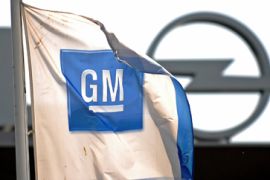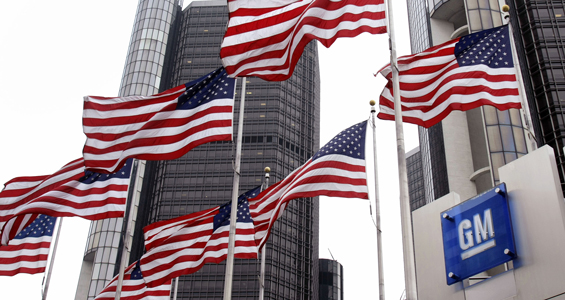Glory days over for US car industry
Nationalisation of GM an ignominious chapter for once grand and innovative industry.

 |
| The once proud symbol of US capitalism is about to be nationalised [AFP] |
Once the proud symbol of muscular American capitalism, General Motors will now, in effect, be nationalised, with the US treasury taking an ownership stake amounting to about 70 per cent of the company in return for forking out more than another $30bn in taxpayer-funded loans.
The Obama administration is taking these steps reluctantly, as a last resort. But the alternative is politically unthinkable.
Keep reading
list of 4 itemsChina’s economy beats expectations, growing 5.3 percent in first quarter
Inside the pressures facing Quebec’s billion-dollar maple syrup industry
Manipur’s BJP CM inflamed conflict: Assam Rifles report on India violence
Total collapse of GM and the liquidation of its constituent parts, perhaps sold off to European and Chinese industrial companies, would make Barack Obama look like Herbert Hoover, who presided over the United States’ Great Depression in the 1930s.
It would throw tens of thousands of US workers out of their jobs, deliver a body-blow to the US economy and cripple the country’s industrial infrastructure.
‘Bloated’ industry
 |
| Dozens of plants have already been shuttered and thousands of workers let go [Reuters] |
Nevertheless it’s an ignominious chapter for the once grand and innovative – but more often bloated and complacent – US auto industry.
When I was growing up in Indiana, everyone drove an American-made car. My mother and father ferried their five kids around in gloriously oversized Chevrolets, Oldsmobiles and Buicks. I learnt to drive behind the wheel of a vast, baby-blue Chevy Malibu with bench seats, crank-up windows and eight cylinders. Oh, baby. That was a sweet ride. Do you have any idea how many teenagers you can cram into one of those things?
Of course, you could fill up the tank for a few bucks back in those days. And even though I was a pretty lousy driver, the minor scrapes and dents I inflicted on the family auto weren’t life threatening.
That was lucky for me, because the cars of my youth were essentially death traps. GM Ford and Chrysler fought every move to improve car safety – opposing seatbelts, collapsible steering wheels, air bags and other innovations. Using their well-oiled Washington lobbying machinery, they successfully battled efforts to make more fuel-efficient cars, and sabotaged electric car research.
GM prospered in the golden era of big cars festooned with gleaming chrome and fins, but gradually, Detroit got sloppy. The cars of the 70s and 80s were junky and unreliable, far less mechanically and technologically up-to-date compared with the growing stream of Japanese, German and Korean imports. Still, GM, Ford and Chrysler kept on doing things the same old way.
Tom Wilkinson, a spokesman for GM, says “when you’re wildly successful for 75 years with a specific business model and a specific way of doing business, it’s very hard to change that – even when you realise it may not be working”.
Ralph Nader, a consumer advocate and former presidential candidate, was one of the first to challenge Detroit’s dangerous cars.
His landmark book, Unsafe at Any Speed, published in 1965, led to greater scrutiny of the industry and more concern for safety.
‘Self-destructive’
Today, Nader reflects on Detroit’s self destructive ways.
“Billions and billions of dollars,” Nader says, were spent on “increasing the power of their engines, which was never needed”.
“They had this mania – almost a narcotic – putting billions of dollars there, and then they spent billions buying back their stock, and they didn’t put it in innovation, they didn’t put it in service, and Toyota – among others – and Honda cleaned their clock.”
In the cheap-gas era, fuel-guzzling Hummers, Navigators and Escalades reaped big profits for Detroit.
But when oil prices soared, GM and its American brethren had no alternatives to offer cost-conscious consumers.
Generous worker pay scales, medical benefits and retirement packages saddled GM with crushing debt obligations. A GM executive once described the company to me as “basically a very large healthcare company that makes automobiles as a sideline”. By the 1990s, GM was spending more on health benefits than on the steel it made its vehicles out of.
Of course, if the US had a government-run healthcare system like every other industrialised country, GM and other American companies would not face such an enormous competitive disadvantage. But that’s the system the US has. As a result, those big debts made it impossible for GM to raise money when the credit crisis hit, forcing it to go begging to Washington.
GM now has $185bn in liabilities it will seek to shed through bankruptcy. Dozens of plants have already been shuttered and thousands of workers let go. GM shares sell for below $2 today – down from $40 less than two years ago.
Whatever vestiges of the US auto industry emerge from the bankruptcy wreckage, the glory days are over for good.